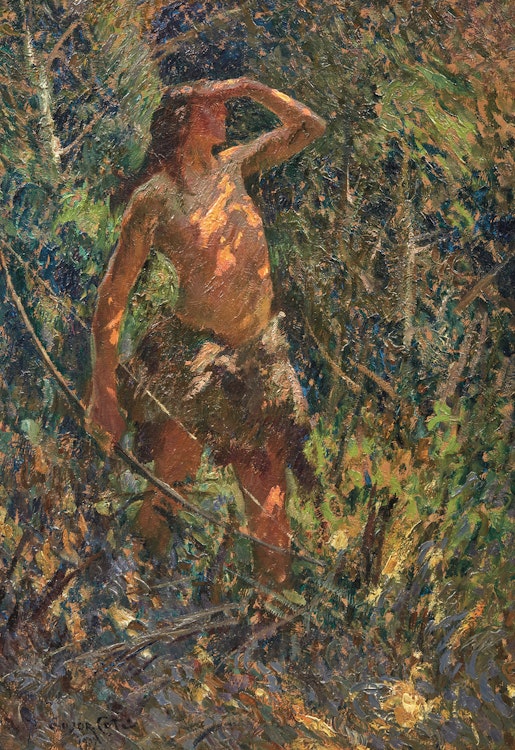Indian in the Wood (Indien à la chasse) by Marc-Aurèle de Foy Suzor-Coté

Marc-Aurèle de Foy Suzor-Coté
Indian in the Wood (Indien à la chasse)
oil on canvas
signed and dated 1907 lower left
25.75 x 18.5 in ( 65.4 x 47 cm )
Auction Estimate: $50,000.00 - $60,000.00
Price Realized $48,000.00
Sale date: May 30th 2024
Watson Art Galleries, Montreal
Galerie Bernard Desroches, Montreal
Private Collection
William Scott & Sons Gallery, Montreal, December 1907-January 1908 as "Indian in the Wood"
"6th Annual Exhibition", Canadian Art Club, Art Museum of Toronto (Public Reference Library Building), Toronto, 29 April-31 May 1913, no. 33 as "Indian Hunting in the Woods"
Watson Art Galleries, Montreal, 16-27 November 1927, no. 3 as "Indian in the Woods"
"50th Spring Exhibition", Art Association of Montreal, 16 March-16 April 1933, no. 308 as "Indien chassant à l'arc"
"Suzor-Coté, 1869-1937, Light and Matter", Musée de Quebec; travelling to the National Gallery of Canada, Ottawa, 10 October 2002-11 May 2003, no. 49 as "Indian Hunting in the Woods"
'Paintings and Sculpture Shown', "The Montreal Daily Star", 24 December 1907, page 12
Laurier Lacroix, "Suzor-Coté, 1869-1937, Light and Matter", Québec/ Ottawa, 2002, no. 49, pages 137, 144, reproduced page 145
Suzor-Coté would go on to have a successful career as a painter of figures, in oil painting, pastel and bronze. Inspired by French Realist artists such as Jean-François Millet, Suzor-Coté focused on portraying the Québecois peasants in their daily life through portraits and genre scenes. In the early 1900s, Suzor-Coté received many commissions to paint portraits of members of the social elite, as well as one of Sir Wilfrid Laurier in 1909. In these artworks he enlivened the poses and portrayed a more official character to his sitters.
Depicting an Aboriginal man hunting, "Indian in the Wood" is an atypical subject within Suzor-Coté’s category of figural work. The artwork was part of the artist’s brief exploration of the genre of historical painting, serving as a preparatory work for the large painting "Jacques Cartier Meeting the Indians at Stadacona", 1535. Laurier Lacroix writes that on Cartier’s second voyage, “he returned from France with the two sons of Chief Donnacana, whom he had taken as guides for his first exploration in 1534, when the mythical meeting between the two peoples had taken place. In 1535, Stadacona was inhabited by the Iroquois, depicted by Suzor-Coté as the natural sons of the forest.” Lacroix also notes that in 1907, Suzor-Coté painted another version of one of the Iroquois men in the forest, shielding his eyes from the sun, which is "Indian in the Wood", depicting the figure with the same arm pose as in the large historical scene.
"Jacques Cartier Meeting the Indians at Stadacona", 1535 caused a stir in 1907. The artist’s painting abilities were praised, particularly his separated brushstrokes and his ability to create atmosphere. The content of the painting was criticized, as it was not seen as an accurate historical account, due to Jacques Cartier being too handsome, and the French men’s clothes being too formal and in pristine condition (considering they had just arrived after four months at sea), and the artist “giving into exoticism” when portraying the Iroquois people. Lacroix writes that this painting brought up more general questions surrounding the practice of painting historical events, such as: “How was one to go about representing historical facts four centuries after they took place? How should they be interpreted, and how should the episode be treated both formally and stylistically?”
Share this item with your friends
Marc-Aurèle de Foy Suzor-Coté
(1869 - 1937) RCA
Suzor-Coté was born in 1869 in the village of Arthabaska, Quebec. Although the young Marc-Aurèle de Foy Suzor-Coté excelled in both musical and artistic pursuits, his love of painting won precedence and he travelled to Paris in 1891 for three years of art studies at the École de beaux-arts. He returned to North America briefly, pursuing commission work, before returning to Europe for an extended period between 1897 and 1907.
By 1906 he had left behind the academic realism of his early work, developing instead a bold impressionistic style. Once back in Canada he found his greatest inspiration in the Canadian landscape itself. He painted landscape in a forceful impressionistic style which was unfamiliar to Canadian audiences of the time.
The multi-talented Suzor-Coté was also easily able to make the shift from painting to working in three dimensions. His bronzes were cast in New York at the Roman Bronze Works, and became sought after by collectors in Canada and the United States. Suzor-Coté won the Jessie Dow prize for best painting at the Art Association of Montreal in 1914 and again in 1925. By 1925, he had made a significant contribution to impressionism in Canada, influencing younger artists to paint the Canadian landscape in a new manner.

